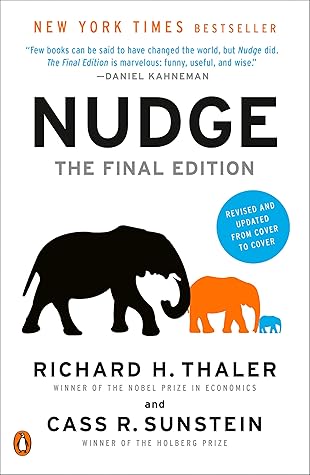More on this book
Community
Kindle Notes & Highlights
As good architects know, seemingly arbitrary decisions, such as where to locate the bathrooms, will have subtle influences on how the people who use the building interact.
As we shall see, small and apparently insignificant details can have major impacts on people’s behavior. A good rule of thumb is to assume that everything matters.
The insight that everything matters can be both paralyzing and empowering. Good architects realize that although they can’t build the perfect building, they can make some design choices that will have beneficial effects. The location of the coffee machines, for example, may influence workplace interaction.
defaults are often quite powerful.
If private companies or public officials favor one set of outcomes, they can greatly influence people by choosing it as the default.
(defaults are often perceived to be hints that they are the recommended option).
Freedom to choose is the best safeguard against bad choice architecture.
Choosers are human, so designers should make life as easy as possible. Send reminders (but not too many!) and then try to minimize the costs imposed on those who, despite your (and their) best efforts, space out.
However, even Albert Einstein, Bill Gates, and Steve Jobs would probably be fooled by those tables. That does not mean something is wrong with us as humans, but it does mean that our understanding of human behavior can be improved by appreciating how and when people systematically go wrong.
sensible shortcuts,
Anchors can even influence how you think your life is going.
In one experiment, college students were asked two questions: (a) How happy are you? (b) How often are you dating? When the two questions were asked in this order, the correlation between the two questions was quite low (.11). But when the question order was reversed, so that the dating question was asked first, the correlation jumped to .62. Apparently, when prompted by the dating question, the students use what might be called the “dating heuristic” to answer the question about how happy they are. “Gee, I can’t remember when I last had a date! I must be miserable.” Similar results can be
...more
entering one’s own amount requires some calculations and a couple extra steps. By contrast, just clicking one of the buttons is easy!
Haggag was able to compare the tips from two cab companies, one of which offered 15, 20, and 25 percent tip suggestions, whereas the other had defaults of 20, 25, and 30 percent. On balance, the screen with the relatively higher default tips significantly increased drivers’ earnings, because they increased the average tip. But interestingly, they also provoked an increase in the number of riders who offered no tip at all.
This is connected with the behavioral phenomenon of reactance: when people feel ordered around, they might get mad and do the opposite of what is being ordered (or even suggested).
Clever negotiators often get amazing deals for their clients by producing an opening offer that makes their adversary thrilled to pay half that very high amount. But keep that notion of reactance in mind. If you get greedy, you might end up with nothing.
A good way to get people to take more precautions about a potential hazard is to remind them of a related incident in which things went wrong; a good way to increase people’s confidence is to remind them of a similar situation in which everything worked out for the best.
Most people said that Linda was less likely to be a bank teller than to be a bank teller and active in the feminist movement.
Unrealistic optimism can explain a lot of individual risk-taking, especially in the domain of risks to life and health. Asked to envision their future, students typically say that they are far less likely than their classmates to be fired from a job, to have a heart attack or get cancer, to be divorced after a few years of marriage, or to have a drinking problem. Older people underestimate the likelihood that they will be in a car accident or suffer major diseases.
if people are reminded of a bad event, they may not continue to be so optimistic.
Roughly speaking, the prospect of losing something makes you twice as miserable as the prospect of gaining the same thing makes you happy.
Once you have a mug, you don’t want to give it up. But if you don’t have one, you don’t feel an urgent need to buy one.
One of the causes of status quo bias is a lack of attention. Many people often adopt what we call the “yeah, whatever” heuristic.
On most streaming networks if you do nothing when you reach the end of one episode, the next one just starts showing. At that point many viewers (implicitly) say, “yeah, whatever,” and keep watching. Many an intended short evening has dragged long into the night as a result, especially on shows with cliffhanger endings.
“Of one hundred patients who have this operation, ninety are alive after five years.”
“Of one hundred patients who have this operation, ten are dead after five years.”
In numerous experiments, people react very differently to the information that “ninety of one hundred are alive” than to “ten of one hundred are dead”—even though the content of the two statements is exactly the same.
If the government wants to encourage energy conservation, option (b) looks like a stronger nudge.
Much like status quo bias, framing effects are exacerbated by the Human tendency occasionally to be somewhat mindless, passive decision makers.


